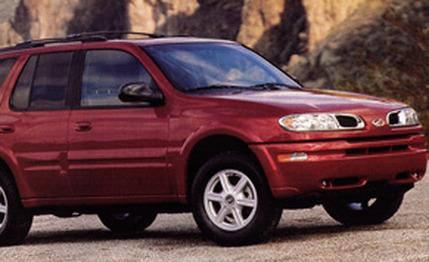
 First Drive Review
First Drive Review
The General Motors trio of medium-size sport-utility vehicles -- the Chevrolet Blazer, the GMC Jimmy and Envoy, and the Oldsmobile Bravada--have soldiered along with surprisingly strong sales, given their dated platform and powertrain, but they're bolstered by incentives. They're also overdue for an update, and for the 2002 model year, they'll get one.
Boy, will they.
First out of the box will be the Oldsmobile Bravada in the first quarter of 2001, followed by the GMC Envoy (the Jimmy is dead) and the Chevrolet TrailBlazer (ditto the Blazer). All three share a new engine and an all-new platform, no longer bound by the constraints posed by the compact-pickup chassis the current models wear. (This means, among other things, no big annoying hump in the floor of the front passenger side to clear the exhaust system.)
There will also be a new small Chevrolet and GMC pickup, and that platform will spawn another completely different SUV. GM is spending $700 million on its Oklahoma City plant to tool up for this new small SUV, though it is unrelated, mechanically, to the Bravada and its two corporate cousins. Their new body-on-(hydroformed)-frame chassis is shared with no other vehicles.
And although the Bravada, the TrailBlazer, and the Envoy will share a powertrain, GM is going to considerable pains and expense to differentiate the three. The Olds is the most sophisticated and carlike, and more than 70 percent of its body panels are to be unique -- only the windshield, the front doors, the roof, and the rear liftgate are shared with the Chevrolet and GMC.
Overall, the Bravada is 6.6 inches longer, 4.2 inches wider, 5.8 inches taller, and some 350 pounds heavier than the current model. The wheelbase has been increased from 107.0 to 113.0 inches. Likewise, interior dimensions have increased in most areas, including head, shoulder, and rear leg room. With the rear seats folded down, cargo capacity is increased from the current 74.1 cubic feet to 83.3.
A substantial roster of equipment comes standard, including leather seating surfaces, the OnStar communications system, front and seat-mounted-side airbags, stereo and climate controls on the steering wheel, eight-way power front seats, heated outside mirrors, and a stereo system with compact disc and cassette players. Wood trim -- well, it's a woodlike substance, but it looks real -- is spread liberally front and rear.
The 2002 Bravada will be available with all-wheel drive or rear-wheel drive, with the two-wheel-drivers getting traction control and a locking rear differential as standard equipment. The all-wheel-drive system is comparable to the current Bravada's system and continues to be called SmartTrak. Designed primarily for paved conditions, its full-time system lacks low-range gearing, but it can shift torque to the wheels that need it.
The 2002 Bravada still has a solid rear axle. An independent rear suspension was seriously considered but rejected. The engineers contended that, by swapping the old model's stiff leaf springs for a new five-link rear suspension suspended by air springs, they could provide the ruggedness needed to tow 5800 pounds and still get a much smoother ride. The rear air bladders also provide load leveling.
The Bravada comes with P255/60R-17 Michelin Cross Terrain radials mounted on six-spoke cast aluminum wheels that can be had with chrome plating as an option. There's also an all-new anti-lock braking system for the four-wheel disc brakes.
The biggest news, detailed in the sidebar, is the all-new 4.2-liter in-line six-cylinder engine that GM says will pump out more than 250 horsepower and 250 pound-feet of torque. ("We don't want to get into a horsepower war with the competition," said one Olds executive, but the consensus is about 260.)
GM execs recognize they'll have a selling job to do to convince customers that an in-line six is as good as or better than a V-8; you can almost hear a Dodge salesman saying, "Our Durango has a V-8, and the GMs have just an in-line six-cylinder, like we used to sell 20 years ago." The aluminum 4.2 is quite sophisticated and smooth-running, and it's a lot easier to package. Engineers, for instance, were able to locate the small catalytic converter right up next to the engine, where it's the most effective and out of the way. The 4.2 and its four-speed automatic transmission will be the only powertrain choice.
The current all-wheel-drive Bravada, powered by the ancient 190-hp, 4.3-liter V-6, sells for about $32,000 base. The price will rise for the 2002 model but should still be less than $35,000, slotting in right there with other newcomers such as the Acura MDX. It looks good on paper and in person. Soon, we'll let you know how it works in the real world.